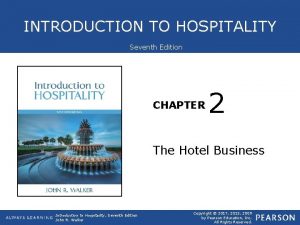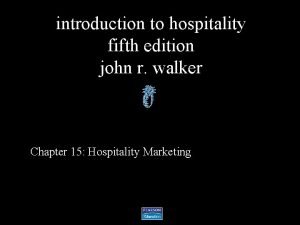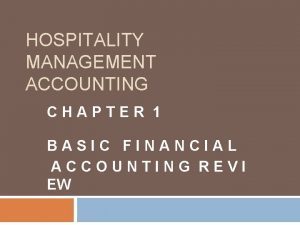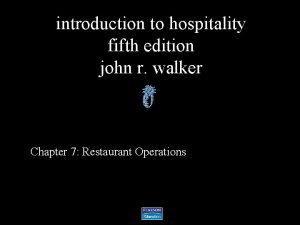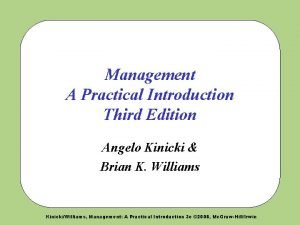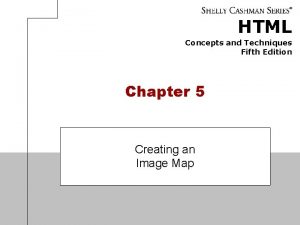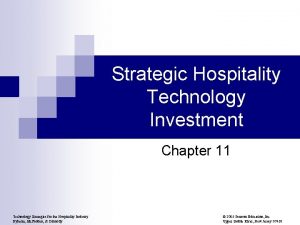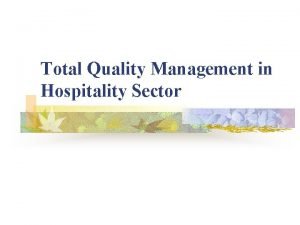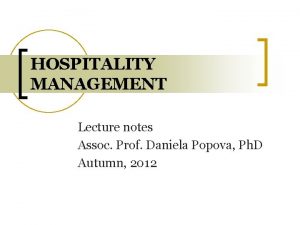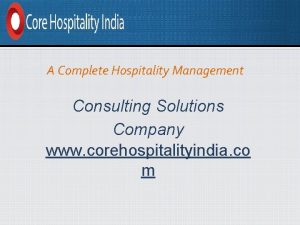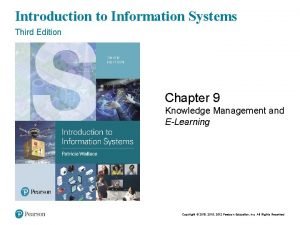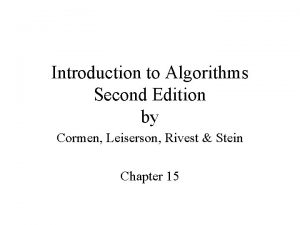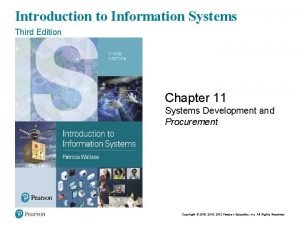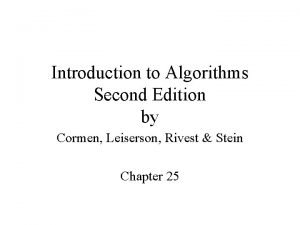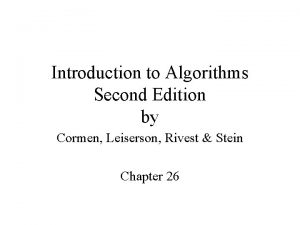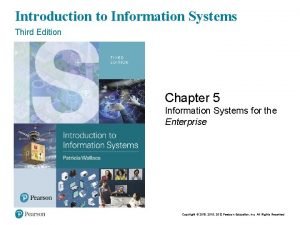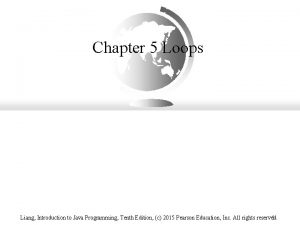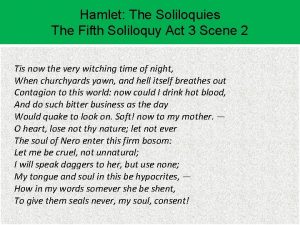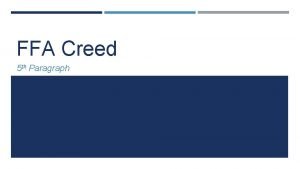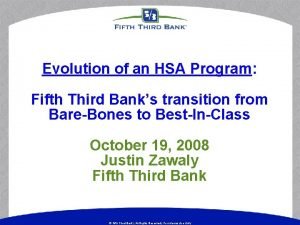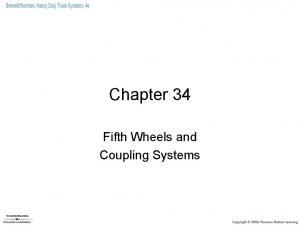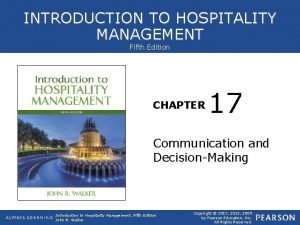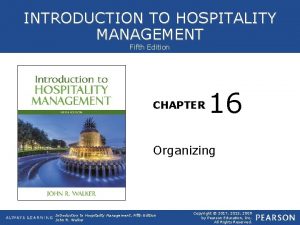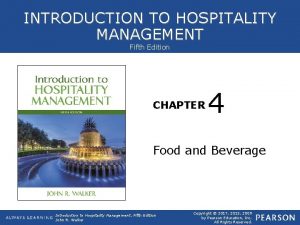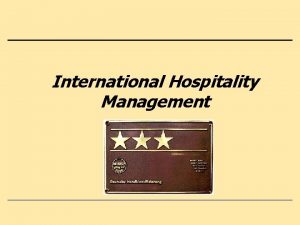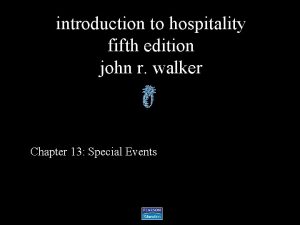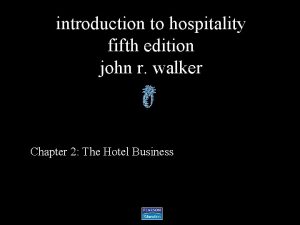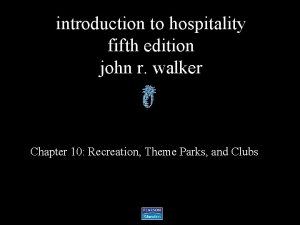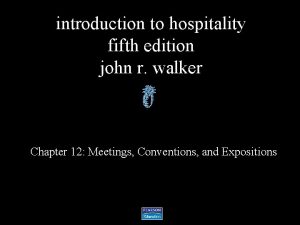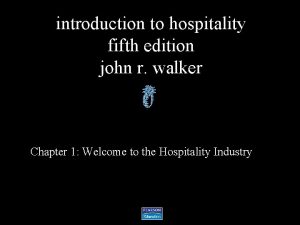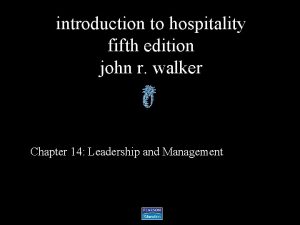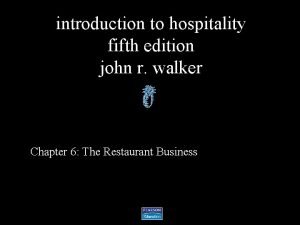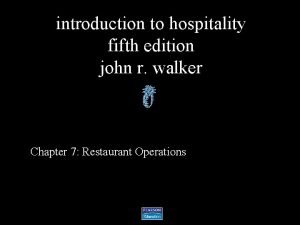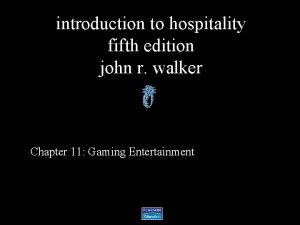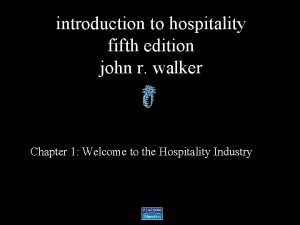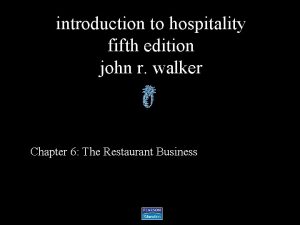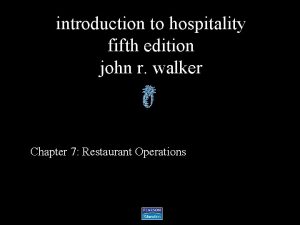INTRODUCTION TO HOSPITALITY MANAGEMENT Fifth Edition CHAPTER 18






















































- Slides: 54

INTRODUCTION TO HOSPITALITY MANAGEMENT Fifth Edition CHAPTER 18 Control Introduction to Hospitality ICD-10 -CM/PCS Coding: A Management, Map to Success Fifth Edition Lorraine John R. Walker M. Papazian-Boyce Copyright © 2017, 2013, 2009 by Pearson Education, Inc. All Rights Reserved.

Chapter Objectives • After reading and studying this chapter, the student should be able to do the following: 1. 2. 3. 4. Define control. Give reasons why control is important. Describe the five-step control process. Distinguish among the three types of control. continued on next slide Introduction to Hospitality ICD-10 -CM/PCS Coding: A Management, Map to Success Fifth Edition Lorraine John R. Walker M. Papazian-Boyce Copyright © 2017, 2013, 2009 by Pearson Education, Inc. All Rights Reserved.

Chapter Objectives • After reading and studying this chapter, the student should be able to do the following: 5. Explain the important financial controls. 6. Describe the qualities of an effective control system. 7. Outline the contemporary issues in control. Introduction to Hospitality ICD-10 -CM/PCS Coding: A Management, Map to Success Fifth Edition Lorraine John R. Walker M. Papazian-Boyce Copyright © 2017, 2013, 2009 by Pearson Education, Inc. All Rights Reserved.

What is Control? • Control provides a way to check actual results against expected results. • Action can then be taken to correct the situation if the results are too far from the expected outcome. • Control is the management function that provides information about the degree to which goals and objectives are being accomplished. continued on next slide Introduction to Hospitality ICD-10 -CM/PCS Coding: A Management, Map to Success Fifth Edition Lorraine John R. Walker M. Papazian-Boyce Copyright © 2017, 2013, 2009 by Pearson Education, Inc. All Rights Reserved.

What is Control? • Management engages in controlling by monitoring activities and taking corrective actions whenever the goals are not being met. • An effective control system ensures that activities that lead to the attainment of the organization’s goals are completed. continued on next slide Introduction to Hospitality ICD-10 -CM/PCS Coding: A Management, Map to Success Fifth Edition Lorraine John R. Walker M. Papazian-Boyce Copyright © 2017, 2013, 2009 by Pearson Education, Inc. All Rights Reserved.

What is Control? • It is also about providing guidelines and mechanisms to keep things on track. Introduction to Hospitality ICD-10 -CM/PCS Coding: A Management, Map to Success Fifth Edition Lorraine John R. Walker M. Papazian-Boyce Copyright © 2017, 2013, 2009 by Pearson Education, Inc. All Rights Reserved.

Why is Control Important? • Control is important because it’s the final link in the management functions. • It’s the only way managers know whether organizational goals are being met and, if not, why not. continued on next slide Introduction to Hospitality ICD-10 -CM/PCS Coding: A Management, Map to Success Fifth Edition Lorraine John R. Walker M. Papazian-Boyce Copyright © 2017, 2013, 2009 by Pearson Education, Inc. All Rights Reserved.

Why is Control Important? • Controlling is involved with planning, organizing, and leading. • An effective control system is important because managers need to delegate duties and empower employees to make decisions. Introduction to Hospitality ICD-10 -CM/PCS Coding: A Management, Map to Success Fifth Edition Lorraine John R. Walker M. Papazian-Boyce Copyright © 2017, 2013, 2009 by Pearson Education, Inc. All Rights Reserved.

The Control Process • Setting Standards – Standards are normally set in terms of quantity, quality, finances, or time. – When developing a method of measurement, one must be absolutely sure that the goals are indeed measurable. continued on next slide Introduction to Hospitality ICD-10 -CM/PCS Coding: A Management, Map to Success Fifth Edition Lorraine John R. Walker M. Papazian-Boyce Copyright © 2017, 2013, 2009 by Pearson Education, Inc. All Rights Reserved.

The Control Process • Measuring – Personal observation—by monitoring subordinates to make sure things are done right—is the simplest and most common way of comparing actual performance to standards. continued on next slide Introduction to Hospitality ICD-10 -CM/PCS Coding: A Management, Map to Success Fifth Edition Lorraine John R. Walker M. Papazian-Boyce Copyright © 2017, 2013, 2009 by Pearson Education, Inc. All Rights Reserved.

The Control Process • How We Measure – Management by walking around (MBWA) is the best way to make personal observations. – Statistical reports provide information in the form of data that measures results and can be used for comparative purposes. continued on next slide Introduction to Hospitality ICD-10 -CM/PCS Coding: A Management, Map to Success Fifth Edition Lorraine John R. Walker M. Papazian-Boyce Copyright © 2017, 2013, 2009 by Pearson Education, Inc. All Rights Reserved.

The Control Process • How We Measure – They also use charts, graphs, and other displays that are easy to visualize. – Control information can be acquired through oral reports, conferences, meetings, one-on-one conversations, or telephone calls. continued on next slide Introduction to Hospitality ICD-10 -CM/PCS Coding: A Management, Map to Success Fifth Edition Lorraine John R. Walker M. Papazian-Boyce Copyright © 2017, 2013, 2009 by Pearson Education, Inc. All Rights Reserved.

The Control Process • How We Measure – The advantage of oral control reports is that they can be quick and allow instant feedback in the form of a two-way conversation. – Written reports generally have more information than oral ones and are usually easy to file and retrieve. Introduction to Hospitality ICD-10 -CM/PCS Coding: A Management, Map to Success Fifth Edition Lorraine John R. Walker M. Papazian-Boyce Copyright © 2017, 2013, 2009 by Pearson Education, Inc. All Rights Reserved.

What We Measure • We measure results to see how they compare with expectations. • What we measure is more critical than how we measure. continued on next slide Introduction to Hospitality ICD-10 -CM/PCS Coding: A Management, Map to Success Fifth Edition Lorraine John R. Walker M. Papazian-Boyce Copyright © 2017, 2013, 2009 by Pearson Education, Inc. All Rights Reserved.

What We Measure • The results we measure include guest satisfaction, labor costs, food and beverage costs, employee satisfaction, rooms and room rates, bed sheets, energy costs, insurance, and labor turnover. • In simple terms, we measure labor costs because they are the highest of the variable costs. continued on next slide Introduction to Hospitality ICD-10 -CM/PCS Coding: A Management, Map to Success Fifth Edition Lorraine John R. Walker M. Papazian-Boyce Copyright © 2017, 2013, 2009 by Pearson Education, Inc. All Rights Reserved.

What We Measure • Because all managers, by definition, coordinate the work of others, criteria such as employee satisfaction or turnover and absenteeism rates can be measured. • Most managers have budgets set in dollar costs for their areas of responsibility. continued on next slide Introduction to Hospitality ICD-10 -CM/PCS Coding: A Management, Map to Success Fifth Edition Lorraine John R. Walker M. Papazian-Boyce Copyright © 2017, 2013, 2009 by Pearson Education, Inc. All Rights Reserved.

What We Measure • Keeping costs within budget is, therefore, a fairly common control measure. • A results-accountability control system must be able to detect deviations from desired results quickly enough to allow for timely corrective management action. Introduction to Hospitality ICD-10 -CM/PCS Coding: A Management, Map to Success Fifth Edition Lorraine John R. Walker M. Papazian-Boyce Copyright © 2017, 2013, 2009 by Pearson Education, Inc. All Rights Reserved.

Comparing Results • Comparing results with expectations shows the amount of variation between actual performance and the standard or expected results. • Some variation is generally seen between the expected and the actual results. continued on next slide Introduction to Hospitality ICD-10 -CM/PCS Coding: A Management, Map to Success Fifth Edition Lorraine John R. Walker M. Papazian-Boyce Copyright © 2017, 2013, 2009 by Pearson Education, Inc. All Rights Reserved.

Comparing Results • The range of variation is the acceptable difference between the actual and expected results. • Managers are concerned with the size and direction of the variance. Introduction to Hospitality ICD-10 -CM/PCS Coding: A Management, Map to Success Fifth Edition Lorraine John R. Walker M. Papazian-Boyce Copyright © 2017, 2013, 2009 by Pearson Education, Inc. All Rights Reserved.

Taking Managerial Action • The final step in the control process is taking managerial action. • Correcting actual performance is used by managers if the source of the performance variation is unsatisfactory. continued on next slide Introduction to Hospitality ICD-10 -CM/PCS Coding: A Management, Map to Success Fifth Edition Lorraine John R. Walker M. Papazian-Boyce Copyright © 2017, 2013, 2009 by Pearson Education, Inc. All Rights Reserved.

Taking Managerial Action • For instance, corrective action may include changing the way the job tasks are done, changing strategy (doing different tasks), changing structure (changing supervisors’/managers’ compensation practices), changing training programs, redesigning jobs, or firing employees. continued on next slide Introduction to Hospitality ICD-10 -CM/PCS Coding: A Management, Map to Success Fifth Edition Lorraine John R. Walker M. Papazian-Boyce Copyright © 2017, 2013, 2009 by Pearson Education, Inc. All Rights Reserved.

Taking Managerial Action • Another decision: Do you use immediate corrective action, which corrects problems at once to get performance back on track, or basic corrective action, which looks at how and why performance has deviated and then proceeds to correct the source of deviation? continued on next slide Introduction to Hospitality ICD-10 -CM/PCS Coding: A Management, Map to Success Fifth Edition Lorraine John R. Walker M. Papazian-Boyce Copyright © 2017, 2013, 2009 by Pearson Education, Inc. All Rights Reserved.

Taking Managerial Action • Effective managers analyze deviations and, when the benefits justify it, take the time to pinpoint and correct the causes of variance. • Good communication is critical to associate control. • The most important reason is that good communication helps associates understand what is expected of them. continued on next slide Introduction to Hospitality ICD-10 -CM/PCS Coding: A Management, Map to Success Fifth Edition Lorraine John R. Walker M. Papazian-Boyce Copyright © 2017, 2013, 2009 by Pearson Education, Inc. All Rights Reserved.

Taking Managerial Action • Employee performance reviews take on added significance when viewed from the control perspective. • Rather than a method of reviewing past performance, they become a control technique. Introduction to Hospitality ICD-10 -CM/PCS Coding: A Management, Map to Success Fifth Edition Lorraine John R. Walker M. Papazian-Boyce Copyright © 2017, 2013, 2009 by Pearson Education, Inc. All Rights Reserved.

Types of Control • Feedforward control focuses on preventing anticipated problems because it takes place in advance of the work activity. • Feedforward controls are helpful in that they encourage managers to prevent problems rather than react to them. continued on next slide Introduction to Hospitality ICD-10 -CM/PCS Coding: A Management, Map to Success Fifth Edition Lorraine John R. Walker M. Papazian-Boyce Copyright © 2017, 2013, 2009 by Pearson Education, Inc. All Rights Reserved.

Types of Control • Concurrent control is a type of control that takes place while a work activity is in progress. • When control is enacted while the work is being performed, management can correct problems before they become too costly. continued on next slide Introduction to Hospitality ICD-10 -CM/PCS Coding: A Management, Map to Success Fifth Edition Lorraine John R. Walker M. Papazian-Boyce Copyright © 2017, 2013, 2009 by Pearson Education, Inc. All Rights Reserved.

Types of Control • Feedback control, the most popular type of control, takes place after the activity is done. • Financial statements are examples of feedback control. continued on next slide Introduction to Hospitality ICD-10 -CM/PCS Coding: A Management, Map to Success Fifth Edition Lorraine John R. Walker M. Papazian-Boyce Copyright © 2017, 2013, 2009 by Pearson Education, Inc. All Rights Reserved.

Types of Control • Feedback control has two advantages over feedforward and concurrent control. – First, feedback provides managers with meaningful information on how effective their planning efforts were and second, feedback control can enhance employee motivation. Introduction to Hospitality ICD-10 -CM/PCS Coding: A Management, Map to Success Fifth Edition Lorraine John R. Walker M. Papazian-Boyce Copyright © 2017, 2013, 2009 by Pearson Education, Inc. All Rights Reserved.

Other Types of Control • Corporate Control – Planning and scheduling work more effectively may save thousands of dollars for departments such as food and beverage and banquets. continued on next slide Introduction to Hospitality ICD-10 -CM/PCS Coding: A Management, Map to Success Fifth Edition Lorraine John R. Walker M. Papazian-Boyce Copyright © 2017, 2013, 2009 by Pearson Education, Inc. All Rights Reserved.

Other Types of Control • Food and Beverage Controls – Most operations take inventory and calculate the food and beverage costs expressed as a percentage of sales at least once, sometimes twice, a month. continued on next slide Introduction to Hospitality ICD-10 -CM/PCS Coding: A Management, Map to Success Fifth Edition Lorraine John R. Walker M. Papazian-Boyce Copyright © 2017, 2013, 2009 by Pearson Education, Inc. All Rights Reserved.

Other Types of Control • Food and Beverage Controls – When you become a manager and assume responsibility for controlling food and beverage items, the first thing to do is to get the locks changed because you have no idea who has access to what. – The second thing is to review all control procedures. continued on next slide Introduction to Hospitality ICD-10 -CM/PCS Coding: A Management, Map to Success Fifth Edition Lorraine John R. Walker M. Papazian-Boyce Copyright © 2017, 2013, 2009 by Pearson Education, Inc. All Rights Reserved.

Other Types of Control • Food and Beverage Controls – If you really want to exercise tight control, insist that all orders have your signature or approval—that way, you know what should be received. – Next, the stores need to be under the authority and responsibility of one person who is held accountable for all items under his/her control. continued on next slide Introduction to Hospitality ICD-10 -CM/PCS Coding: A Management, Map to Success Fifth Edition Lorraine John R. Walker M. Papazian-Boyce Copyright © 2017, 2013, 2009 by Pearson Education, Inc. All Rights Reserved.

Other Types of Control • Operational Financial Controls – At the operational level in the hospitality industry, the financial controls mainly consist of budgets and income statements. – Budgets “guesstimate” the sales figure for the month/year and allow for up to a specific dollar amount to be spent on any cost of goods sold or controllablecosts item. continued on next slide Introduction to Hospitality ICD-10 -CM/PCS Coding: A Management, Map to Success Fifth Edition Lorraine John R. Walker M. Papazian-Boyce Copyright © 2017, 2013, 2009 by Pearson Education, Inc. All Rights Reserved.

Other Types of Control • Operational Financial Controls – Instead of just allowing departments to budget the same amount year in and year out, zero-based budgeting has managers begin with a budget of zero dollars and justify all the cost of goods sold, controllable costs, and capital expenditures. continued on next slide Introduction to Hospitality ICD-10 -CM/PCS Coding: A Management, Map to Success Fifth Edition Lorraine John R. Walker M. Papazian-Boyce Copyright © 2017, 2013, 2009 by Pearson Education, Inc. All Rights Reserved.

Other Types of Control • Operational Financial Controls – Zero-based budgets are used extensively in the hospitality industry as a means of control because they are results driven. – Good managers first control the “big ticket” items that will be most costly if not controlled. continued on next slide Introduction to Hospitality ICD-10 -CM/PCS Coding: A Management, Map to Success Fifth Edition Lorraine John R. Walker M. Papazian-Boyce Copyright © 2017, 2013, 2009 by Pearson Education, Inc. All Rights Reserved.

Other Types of Control • Operational Financial Controls – Labor costs in a hospitality operation are the largest of the controllable costs. – Labor costs, like any other, need to be controlled in-line with sales. continued on next slide Introduction to Hospitality ICD-10 -CM/PCS Coding: A Management, Map to Success Fifth Edition Lorraine John R. Walker M. Papazian-Boyce Copyright © 2017, 2013, 2009 by Pearson Education, Inc. All Rights Reserved.

Other Types of Control • Operational Financial Controls – In managerial accounting, food and beverage costs are the next largest cost to be controlled after labor costs. – All food and beverage items need to be costed and priced in advance to yield a certain percentage. Introduction to Hospitality ICD-10 -CM/PCS Coding: A Management, Map to Success Fifth Edition Lorraine John R. Walker M. Papazian-Boyce Copyright © 2017, 2013, 2009 by Pearson Education, Inc. All Rights Reserved.

Qualities of an Effective Control System • Effective control systems tend to have certain characteristics in common. • All effective control systems exhibit the following ten characteristics: – Accuracy, timeliness, economy, flexibility, understandability, reasonable criteria, strategic placement, emphasis on exceptions, multiple criteria, and corrective action. Introduction to Hospitality ICD-10 -CM/PCS Coding: A Management, Map to Success Fifth Edition Lorraine John R. Walker M. Papazian-Boyce Copyright © 2017, 2013, 2009 by Pearson Education, Inc. All Rights Reserved.

Contingency Plans and Controls • The most important contingency plan factor that affects the design of an organization’s control system is size of the organization. • As organizations increase in size, direct supervision is likely to be supplemented by an expanding formal control system of reports, regulations, and rules. continued on next slide Introduction to Hospitality ICD-10 -CM/PCS Coding: A Management, Map to Success Fifth Edition Lorraine John R. Walker M. Papazian-Boyce Copyright © 2017, 2013, 2009 by Pearson Education, Inc. All Rights Reserved.

Contingency Plans and Controls • Very large organizations typically have highly formalized and impersonal feedforward and feedback controls. • As you move up in the organization’s hierarchy, there is a greater need for several different types of control; this reflects increased operational complexities. Introduction to Hospitality ICD-10 -CM/PCS Coding: A Management, Map to Success Fifth Edition Lorraine John R. Walker M. Papazian-Boyce Copyright © 2017, 2013, 2009 by Pearson Education, Inc. All Rights Reserved.

Adjusting Controls for Cultural Differences • In a global hospitality corporation, managers of foreign operations tend to be controlled less directly by the home office. • Because distance creates a tendency to formalize controls, the home office of a global company often relies on extensive formal reports for control. continued on next slide Introduction to Hospitality ICD-10 -CM/PCS Coding: A Management, Map to Success Fifth Edition Lorraine John R. Walker M. Papazian-Boyce Copyright © 2017, 2013, 2009 by Pearson Education, Inc. All Rights Reserved.

Adjusting Controls for Cultural Differences • Global companies rely on the power of information technology to provide speedy control reports of results. • In less technologically advanced countries, managers tend to rely more on direct supervision and highlycentralized decision making for control. Introduction to Hospitality ICD-10 -CM/PCS Coding: A Management, Map to Success Fifth Edition Lorraine John R. Walker M. Papazian-Boyce Copyright © 2017, 2013, 2009 by Pearson Education, Inc. All Rights Reserved.

Contemporary Issues in Control • Workplace Privacy – Employees are hired to work, not to surf the Web checking stock prices, placing bets at online casinos, or shopping for presents for family or friends. continued on next slide Introduction to Hospitality ICD-10 -CM/PCS Coding: A Management, Map to Success Fifth Edition Lorraine John R. Walker M. Papazian-Boyce Copyright © 2017, 2013, 2009 by Pearson Education, Inc. All Rights Reserved.

Contemporary Issues in Control • Workplace Privacy – Another reason why managers monitor employee e-mail and computer usage is that they don’t want to risk being sued for creating a hostile workplace environment because of offensive messages or an inappropriate image displayed on a coworker’s computer screen. continued on next slide Introduction to Hospitality ICD-10 -CM/PCS Coding: A Management, Map to Success Fifth Edition Lorraine John R. Walker M. Papazian-Boyce Copyright © 2017, 2013, 2009 by Pearson Education, Inc. All Rights Reserved.

Contemporary Issues in Control • Workplace Privacy – Concern about sexual harassment is one of the reasons why companies may want to monitor or keep backup copies of all e -mail. continued on next slide Introduction to Hospitality ICD-10 -CM/PCS Coding: A Management, Map to Success Fifth Edition Lorraine John R. Walker M. Papazian-Boyce Copyright © 2017, 2013, 2009 by Pearson Education, Inc. All Rights Reserved.

Contemporary Issues in Control • Employee Theft – A high percentage of all organizational theft and fraud is committed by employees, not outsiders. – Industrial loss-prevention professionals suggest that people steal because the opportunity presents itself through lax controls and favorable circumstances. continued on next slide Introduction to Hospitality ICD-10 -CM/PCS Coding: A Management, Map to Success Fifth Edition Lorraine John R. Walker M. Papazian-Boyce Copyright © 2017, 2013, 2009 by Pearson Education, Inc. All Rights Reserved.

Contemporary Issues in Control • Employee Theft – People steal because they can rationalize whatever they’re doing as being correct and appropriate behavior, and hospitality associates also steal because they often feel underpaid. continued on next slide Introduction to Hospitality ICD-10 -CM/PCS Coding: A Management, Map to Success Fifth Edition Lorraine John R. Walker M. Papazian-Boyce Copyright © 2017, 2013, 2009 by Pearson Education, Inc. All Rights Reserved.

Contemporary Issues in Control • Workplace Violence – Factors contributing to workplace violence include employee stress caused by long working hours, information overload, daily interruptions, unrealistic deadlines, and uncaring managers. Introduction to Hospitality ICD-10 -CM/PCS Coding: A Management, Map to Success Fifth Edition Lorraine John R. Walker M. Papazian-Boyce Copyright © 2017, 2013, 2009 by Pearson Education, Inc. All Rights Reserved.

Controlling Sustainability • Hotels and restaurants as well as other businesses and organizations must constantly monitor and manage the different aspects of sustainable practices, such as energy, waste, lighting, water, heating and cooling, temperature, and other sources that consume energy. continued on next slide Introduction to Hospitality ICD-10 -CM/PCS Coding: A Management, Map to Success Fifth Edition Lorraine John R. Walker M. Papazian-Boyce Copyright © 2017, 2013, 2009 by Pearson Education, Inc. All Rights Reserved.

Controlling Sustainability • Energy Management – There a variety of solutions to lighting controls, including occupancy sensors, time switches, and energy efficient bulbs. continued on next slide Introduction to Hospitality ICD-10 -CM/PCS Coding: A Management, Map to Success Fifth Edition Lorraine John R. Walker M. Papazian-Boyce Copyright © 2017, 2013, 2009 by Pearson Education, Inc. All Rights Reserved.

Controlling Sustainability • Waste Reduction – The tourism industry serves many millions of visitors annually. – The waste generated by tourists constitutes a large portion of a destination’s commercial waste stream. continued on next slide Introduction to Hospitality ICD-10 -CM/PCS Coding: A Management, Map to Success Fifth Edition Lorraine John R. Walker M. Papazian-Boyce Copyright © 2017, 2013, 2009 by Pearson Education, Inc. All Rights Reserved.

Controlling Sustainability • Waste Reduction – Lodging establishments and other businesses are finding that promoting a “green” image provides innumerous benefits, resulting in more long-term cost-savings. Introduction to Hospitality ICD-10 -CM/PCS Coding: A Management, Map to Success Fifth Edition Lorraine John R. Walker M. Papazian-Boyce Copyright © 2017, 2013, 2009 by Pearson Education, Inc. All Rights Reserved.

Trends in Control • Current trends include: – A focus on variable and fixed cost controls: reducing costs without shrinking quality standards or profitability. – Staffing guides and flexible scheduling: use of staffing guides and detailed, yet flexible, staffing schedules to control labor use and expenses. continued on next slide Introduction to Hospitality ICD-10 -CM/PCS Coding: A Management, Map to Success Fifth Edition Lorraine John R. Walker M. Papazian-Boyce Copyright © 2017, 2013, 2009 by Pearson Education, Inc. All Rights Reserved.

Trends in Control • Current trends include: – Labor costs: more care in planning, attentive scheduling, and improving productivity. – Invest in logistics and equipment: to control costs and drive productivity. – Hire and train to reduce turnover: screening, hiring, and training for the future. Introduction to Hospitality ICD-10 -CM/PCS Coding: A Management, Map to Success Fifth Edition Lorraine John R. Walker M. Papazian-Boyce Copyright © 2017, 2013, 2009 by Pearson Education, Inc. All Rights Reserved.
 Introduction to hospitality 7th edition
Introduction to hospitality 7th edition Introduction to hospitality 7th edition
Introduction to hospitality 7th edition John r walker introduction to hospitality management
John r walker introduction to hospitality management Management accounting for hotels and restaurants
Management accounting for hotels and restaurants Principles of marketing fifth european edition
Principles of marketing fifth european edition Appraisals in lazarus's theory of emotion
Appraisals in lazarus's theory of emotion Fundamentals of corporate finance fifth edition
Fundamentals of corporate finance fifth edition Democritus atomic model diagram
Democritus atomic model diagram Molecular biology of the cell fifth edition
Molecular biology of the cell fifth edition Molecular biology of the cell fifth edition
Molecular biology of the cell fifth edition Human anatomy fifth edition
Human anatomy fifth edition Human anatomy fifth edition
Human anatomy fifth edition Tourism the business of hospitality and travel 5th edition
Tourism the business of hospitality and travel 5th edition John r walker introduction to hospitality management
John r walker introduction to hospitality management Marketing for hospitality and tourism 7th edition ppt
Marketing for hospitality and tourism 7th edition ppt Tourism and hospitality marketing
Tourism and hospitality marketing Introduction to information systems 5th edition
Introduction to information systems 5th edition Kinicki: management: a practical introduction 3rd edition
Kinicki: management: a practical introduction 3rd edition Mis chapter 6
Mis chapter 6 Chapter 1
Chapter 1 The fifth discipline chapter summary
The fifth discipline chapter summary Fifth chapter menu
Fifth chapter menu Strategic hospitality technology investment
Strategic hospitality technology investment Tourism industry definition
Tourism industry definition Marketing for hospitality and tourism pearson
Marketing for hospitality and tourism pearson Contemporary approach
Contemporary approach Total quality management in hospitality industry
Total quality management in hospitality industry Goals in hospitality industry
Goals in hospitality industry Complete hospitality management
Complete hospitality management Chapter 2 hospitality and tourism
Chapter 2 hospitality and tourism Marketing an introduction 6th canadian edition
Marketing an introduction 6th canadian edition Introduction to teaching becoming a professional
Introduction to teaching becoming a professional Introduction to sociology 9th edition
Introduction to sociology 9th edition Introduction to radar systems skolnik
Introduction to radar systems skolnik Introduction to information systems 6th edition
Introduction to information systems 6th edition Fundamentals of information systems chapter 1
Fundamentals of information systems chapter 1 Microbiology an introduction 9th edition
Microbiology an introduction 9th edition Introduction to information systems 3rd edition
Introduction to information systems 3rd edition Introduction to algorithms 2nd edition
Introduction to algorithms 2nd edition Introduction to information systems 3rd edition
Introduction to information systems 3rd edition Introduction to algorithms 2nd edition
Introduction to algorithms 2nd edition Introduction to algorithms 2nd edition
Introduction to algorithms 2nd edition Introduction to genetic analysis tenth edition
Introduction to genetic analysis tenth edition Introduction to information systems 3rd edition
Introduction to information systems 3rd edition Introduction to java programming 10th edition quizzes
Introduction to java programming 10th edition quizzes First korotkoff sound
First korotkoff sound Fifth gear loop the loop
Fifth gear loop the loop Creed paragraph 5
Creed paragraph 5 Soliloquy 5 hamlet
Soliloquy 5 hamlet Fifth standard solar
Fifth standard solar Fifth labor of hercules
Fifth labor of hercules Liesl fifth business
Liesl fifth business Paragraph 5 ffa creed
Paragraph 5 ffa creed 53 hsa
53 hsa Compensating fifth wheel
Compensating fifth wheel

